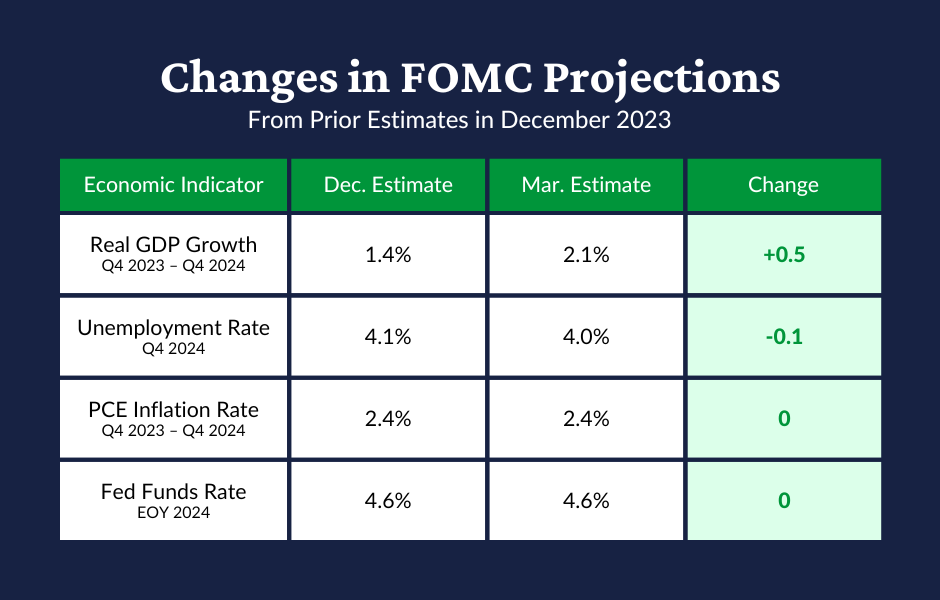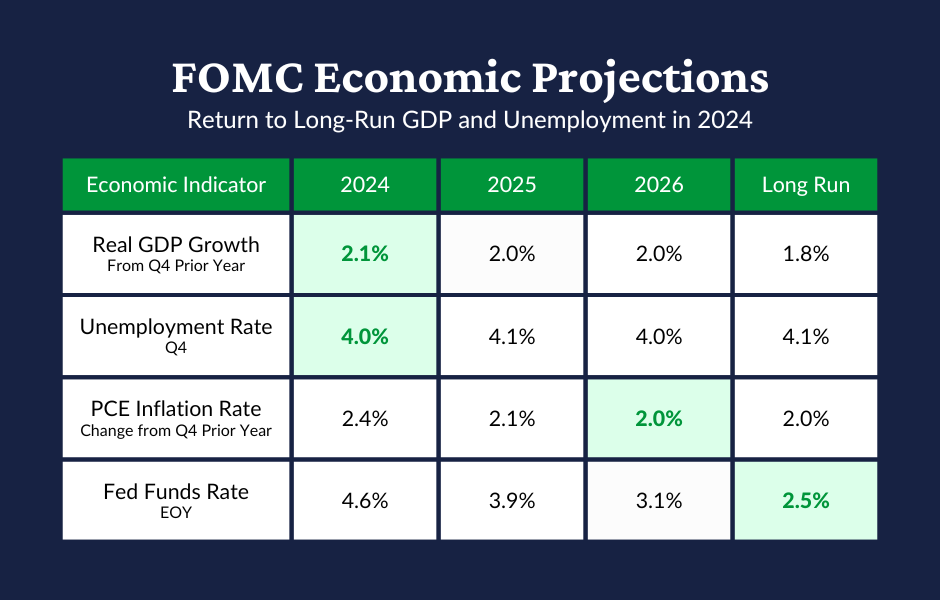
The FOMC met this week to discuss the course of monetary policy and update their projections for the future of the American economy. As forecasted, committee members voted to hold the Fed Funds Rate steady for the fifth consecutive meeting. While this action was well-telegraphed, their updates to economic projections provided a pleasant surprise.
FOMC Members Maintained the Fed Funds Rate
Committee members left the Fed Funds Rate unchanged at a target range of 5.25 – 5.50%. This outcome was almost universally foreseen given the Fed’s recent language and the latest economic data.
Recent Data Supports the Latest Interest Rate Decision
FOMC members pinpointed three pieces of data that influenced their decision to hold rates steady – economic activity, job gains, and inflation. All three have shown robust results in recent months.
GDP Growth
Economic activity is typically measured by Real Gross Domestic Product [GDP] which outperformed expectations last year. In fact, the latest estimate from the Bureau of Economic Analysis shows the annual change in Real GDP was 3.1% from the fourth quarter of 2022 through the fourth quarter of 2023 compared to 2.6% forecasted by the FOMC.
Continued Job Gains
The latest data from the Bureau of Labor Statistics shows that the United States added 275,000 jobs in February – well above the 12-month average of 230,000 new jobs per month. Despite these gains, the unemployment rate increased by 0.2 percentage points to 3.9%. However, a modest rise in unemployment is consistent with the FOMC’s prior projections and the unemployment rate remains very low by historical standards.
Inflation Remains Elevated
According to the latest information from the Bureau of Economic Analysis, Personal Consumption Expenditure [PCE] inflation rose by 2.4% for the 12-month period ending in January. This rate is far below the peak seen in mid-2022, but it remains stubbornly above the Fed’s 2% target.
Overall, the FOMC noted that, “risks to achieving its employment and inflation goals are moving into better balance.” However, the committee went on to say that the “economic outlook is uncertain” and they will continue to monitor incoming data while remaining attuned to inflation risks.
The FOMC’s Updated Outlook for 2024
After two years of economic uncertainty, the FOMC’s latest projections for the U.S. economy in 2024 are a breath of fresh air. The committee releases these forecasts four times per year with the previous update coming in December 2023. Since that time, FOMC members have upgraded their estimate for GDP to 2.1% and downgraded their forecasted unemployment rate to 4.0%. Additionally, the anticipated PCE inflation rate and end-of-year Fed Funds Rate were unchanged at 2.4% and 4.6%, respectively.
See the table below for a summary of changes to FOMC forecasts from December to the most recent projections in March.

Long-Run Economic Forecasts from the FOMC
The economic projections released at the latest meeting also included updates to the outlook for the coming years. These forecasts are summarized in the table below.

Committee members expect both GDP and the unemployment rate to normalize near long-run averages in 2024. However, inflation and the Fed Funds Rate are likely to take longer to reach equilibrium.
The latest projections show an elevated Fed Funds Rate through at least the next three years before the FOMC lowers it to the long-run average of 2.5%. While Americans will have to contend with high interest rates for several more years, inflation is also expected to fall during this time and reach the Fed’s 2% target by 2026.
The Timing of Future Interest Rate Cuts
Given the current level of the Fed Funds Rate, the latest projections suggest three interest rate cuts this year and several more in the coming years. However, the Fed has not provided specific guidance about the timing of the first interest rate cut. Instead, the FOMC statement said, “the committee does not expect it will be appropriate to reduce the target range until it has gained greater confidence that inflation is moving sustainably toward 2 percent.”
While the Fed has not provided a timeline for interest rate cuts, analysts have already placed their bets. The majority of these analysts predict that the first cut will occur in June with further reductions spread throughout the remainder of the 2024 meetings.
The FOMC has repeatedly stated that their interest rate decisions will be made meeting-by-meeting depending on incoming data – particularly changes to the inflation rate. For this reason, business leaders should continue to pay close attention to the latest economic reports to gain additional insight into the Fed’s mindset and forecast the future of interest rates.
Follow ADM For More Actionable Insights and Interest Rate Updates
Our company, the American Deposit Management Co. [ADM] offers deposit management solutions and valuable insights to help your business drive revenue. Join our mailing list to have the latest business, banking, and interest rate news delivered straight to your inbox.
If you’re looking for more valuable information today, check out our Insights page and follow us on LinkedIn, Twitter, and Facebook.
*American Deposit Management Co. is not an FDIC/NCUA-insured institution. FDIC/NCUA deposit coverage only protects against the failure of an FDIC/NCUA-insured depository institution.
